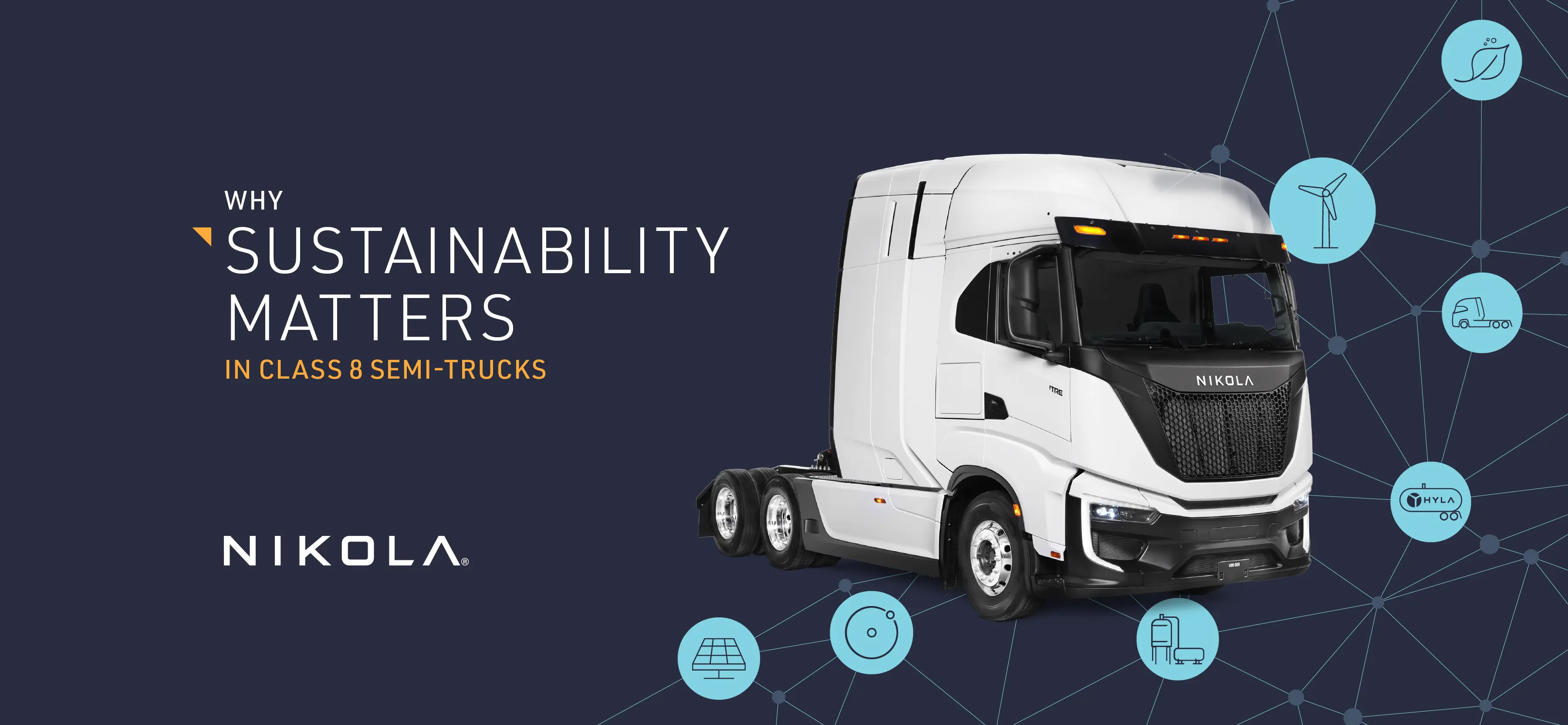Why Sustainability Matters in Class 8 Semi-Trucks
Author: Alexia Bednarz, Head of Sustainability, Nikola

When we think about sustainability, what truly comes to mind first? Recycling? EV cars? Protecting forests? Endangered species? Plastic in the ocean? Most likely not semi-trucks, or at least not how they directly contribute to air pollution. Anyone who has watched a documentary or even a short video on sustainability has seen semi-trucks featured, usually as a B-roll piece representing the roads and highways that often contribute greenhouse gas emissions. This is usually followed by images of a city surrounded by smog or even traffic jams stretching for miles.
Semi-trucks are usually thought of as background players in the climate-change story, rather than a major contributor. In 2022, the Environmental Protection Agency released a report[1] that cited transportation as the top sector responsible for U.S. greenhouse gas emissions, coming in at 28%, just above electricity. Right after light-duty vehicles in the transportation sector came, you guessed it, medium- and heavy-duty trucks.
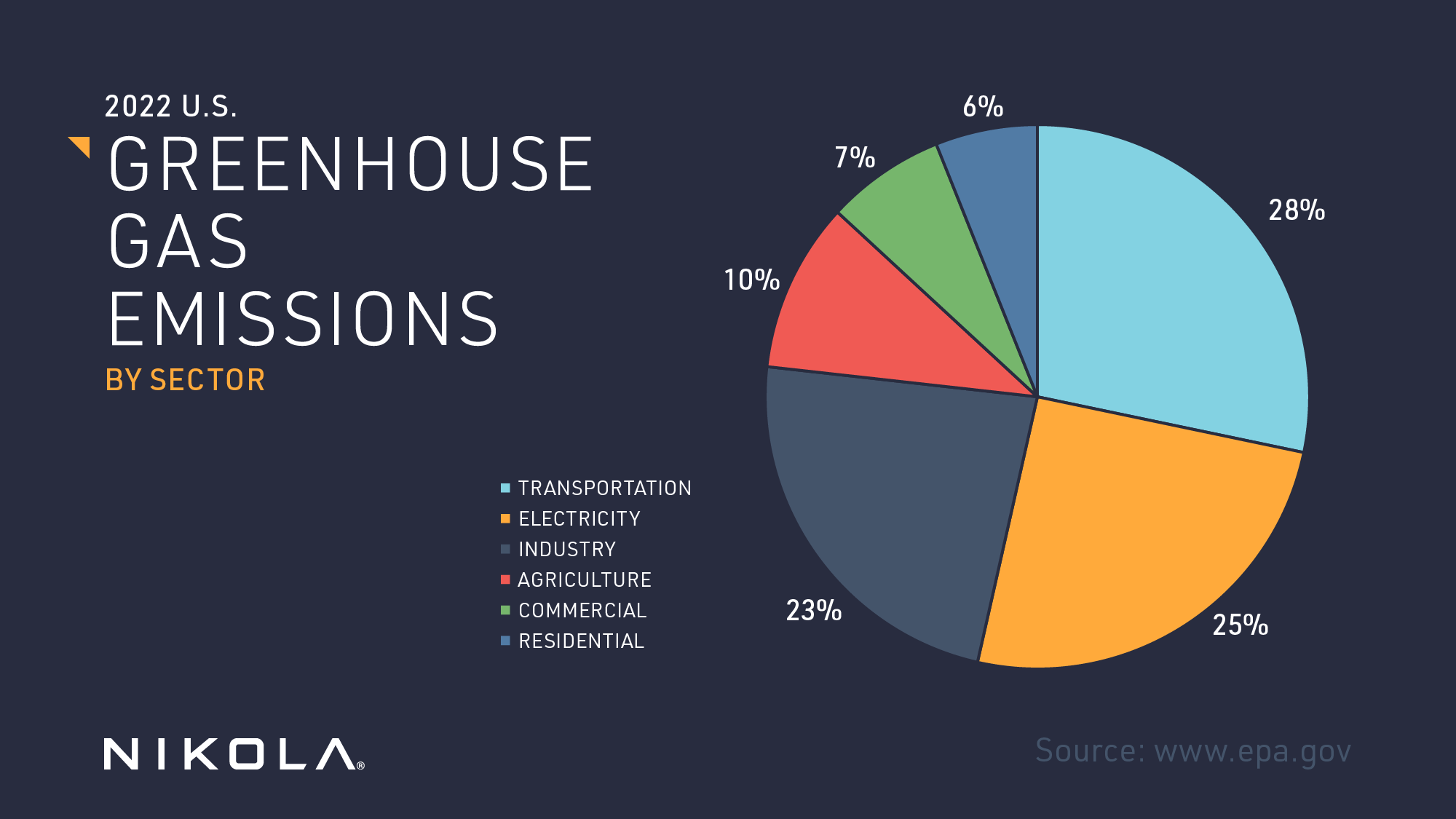
Medium and heavy-duty trucks produce more emissions than passenger cars and rail combined[2]. The medium and heavy-duty trucking industry consumed around 36.5 billion gallons of distillate fuel in 2022.[3] In the U.S. alone, heavy duty, long-haul trucks moved 71% of all freight.[4] This challenging combination of fuel usage, pollution created, and the need for trucks to haul freight is the reason why companies, countries, industries, and entrepreneurs are looking at alternative commercial transportation solutions – and why companies like Nikola exist.
Seemingly, moving an industry like the trucking industry away from diesel seems like a good starting point to solving the daunting climate-change puzzle. But like all change, it takes time, infrastructure, and resources.
More than a Century of Semi-Trucks as the Lifeblood of America
One of the first semi-trucks was conceived by auto-enthusiast and inventor, Alexander Winton, in 1898[5] as a way to deliver cars produced by the Packard Motor Car Company to customers without putting miles on them. This “car hauler” opened the door to the semi-truck industry, slowly evolving to transport goods all over the U.S., ushering in a new way for people to purchase goods outside of their immediate surroundings and without the restrictions of infrastructure, such as train tracks. Winton would go on to work with General Motors (GM)[6] to develop diesel engines in 1913, developing ways to make the engines lighter, faster, and with increased flexibility.
In the early part of the 20th century, the logging industry gained popularity because of the invention of the semi-truck. Peterbilt semi-trucks were used extensively to haul logs starting in 1939 to the surrounding lumber mills.[7] The growth of the trucking industry from there is well-documented history, resulting in semi-trucks transporting more than 70% of goods in the U.S. with 3.5-plus million truck drivers behind the wheel. [8]
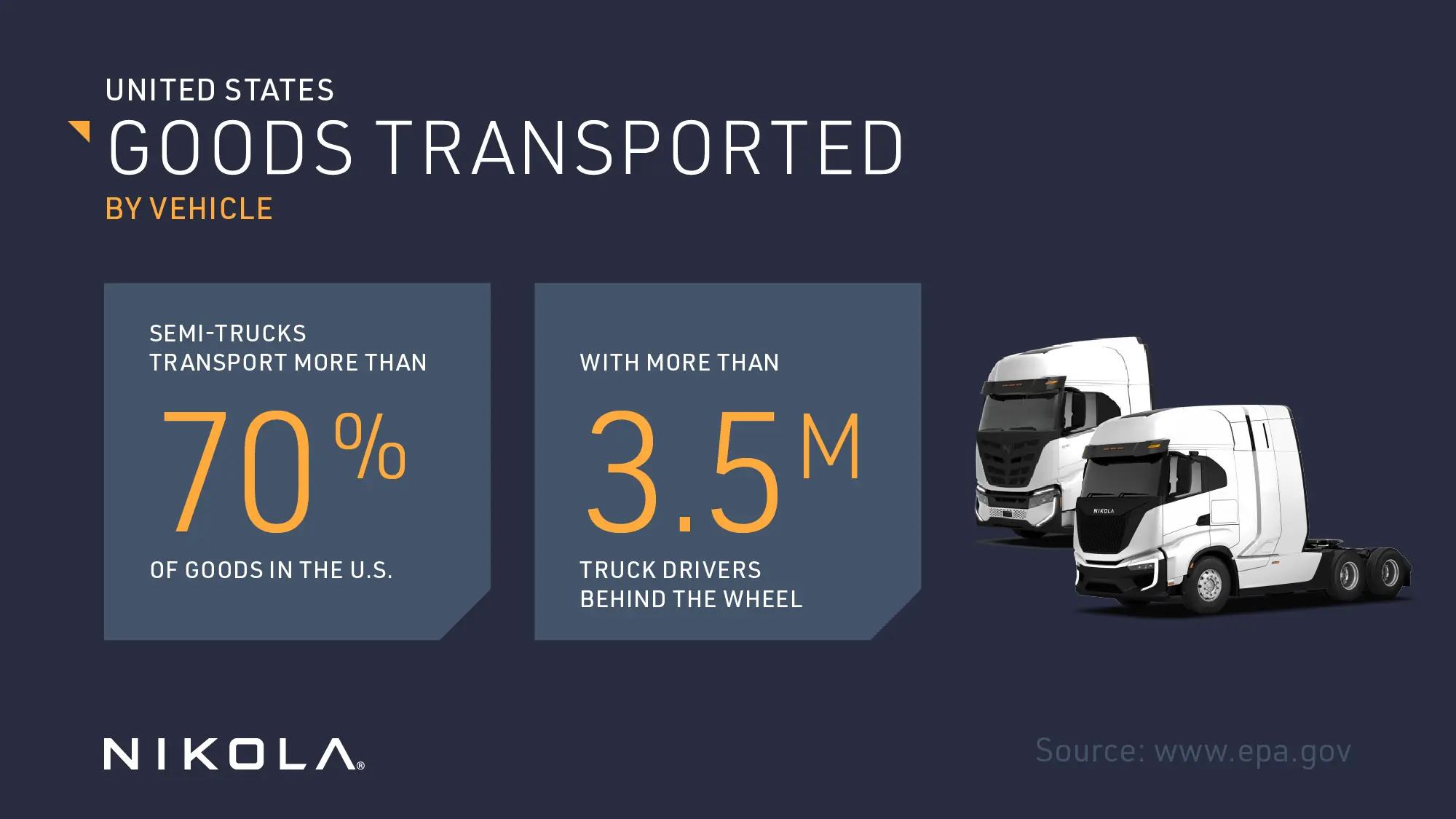
Sustainability Matters for the Trucking Industry
Until we invent a way to beam goods straight into people’s homes, the trucking industry will continue…trucking. People around the world rely on semi-trucks to deliver the goods they need. Trucking is an integral part of the consumer goods supply chain, employing millions, creating revenue, and, unfortunately, contributing to pollution through vehicle emissions. According to the U.S. EPA, more than 3% of all carbon dioxide (CO2) emissions came from long-haul trucks in 2022.[9]
Projections are that by 2025, as international commerce increases and supply chains become more global and complex, shipments of U.S. goods will grow another 23.5%, and by 2040, a total of 45%.
As freight activity in the United States increases, projections are that during this same time frame, growth in air emissions from freight will exceed growth in emissions from all other transportation activities, including passenger transportation. -Environmental Protection Agency, 2024[10]
What can be done to enhance sustainability? Change often starts with businesses committing to zero-emission sustainability initiatives. This includes retailers, manufacturers and fleets that use trucks to deliver goods. Many fleet operators have been around for more than a century, and old habits can be the hardest ones to break when considering new technology. There are newer companies developing and delivering both electric and hydrogen fuel cell electric trucks to customers today, encouraging change through both marketing signals and federal and state regulations.
Below are some of the top sustainability challenges that, if tackled, will likely make a positive impact in the trucking industry by reducing negative impact not just on the environment, but also for drivers, ports, and surrounding communities.
Create change at a rapid scale with zero tailpipe emissions
With tailpipe emissions of battery-electric trucks non-existent and hydrogen fuel cell electric trucks releasing water vapor only, investing in the modernization of fleets can aid rapid reduction of tailpipe emissions if scaled properly. Many fleet operators may have emissions reduction goals, as do their customers. Most major retailers and manufacturers now have sustainability goals that they need to report progress on to their boards, investors, customers, and employees.[11] And while there may be other transportation decarbonization alternatives, the only “big swing” is zero-tailpipe emission trucks which can create substantial change at a rapid pace.
Sustainability goals are increasingly important to consumers and to investors
Sustainability goals set by companies from 2020 to 2023 promise continued progress towards reduced emissions world-wide. Many of these goals involve positively impacting air quality in communities, decarbonization, and implementing zero tailpipe emission fleets. In 2023, the U.N. Global Compact surveyed 2,600 CEOs from 128 countries and 18 industries and found that 98% felt that it was their responsibility to make their businesses more sustainable.[12] Additionally, more than 95% of S&P 500 companies issue sustainability reports but not very many have ESG goals. Linking sustainability goals to ESG reports help investors understand the link between a company’s financial performance and their efforts in sustainability. According to recent reports, 85% of chief investment officers state that ESG is an important factor in their investment decisions.[13]
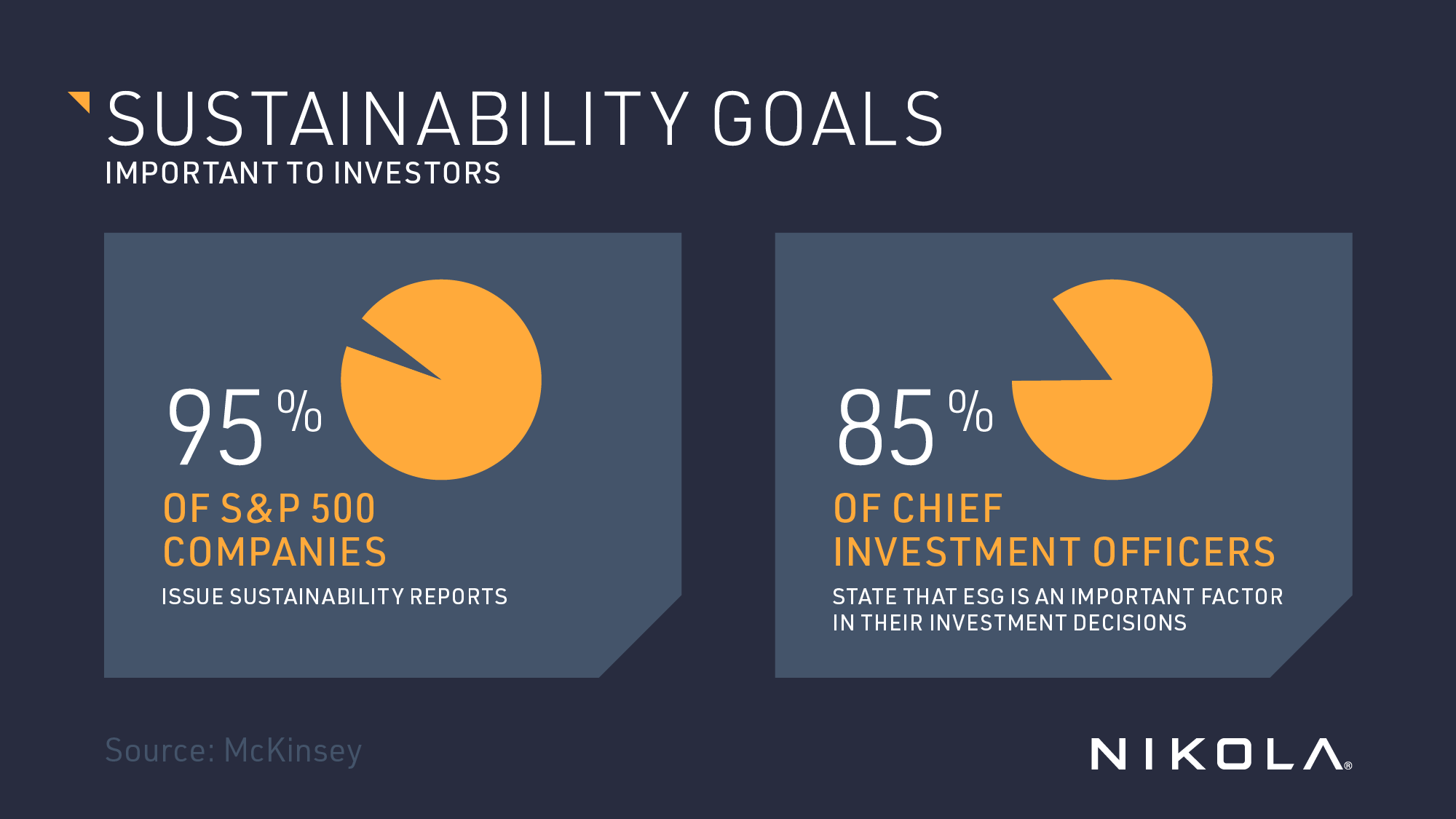
Sustainability reporting started in earnest in early 2000, with companies reporting to CDP, Ecovadis, and the Dow Jones Sustainability Index, among others. While companies do their due diligence to set realistic sustainability goals, both investors and consumers are watching closely to make sure these goals are met. And these publicly-stated goals can show in the pocketbook – products making ESG-related claims for consumers averaged 28% cumulative growth over the past five years versus 20% growth for products making no sustainability goals.[14]
Scope 1 and Scope 3 emission goals can be conquered, and quickly, by re-outfitting fleets with battery-electric and hydrogen fuel cell electric semi-trucks.
The best sustainability value for your company’s dollar
Most companies are looking for ways to pledge, and fulfill, sustainability goals to reduce carbon emissions. Decarbonization is possible in the trucking industry with the purchase of an electric or hydrogen fuel cell electric semi-truck as fleet managers phase out or replace older diesel trucks. Modernizing heavy-duty trucking fleets with zero tailpipe emission vehicles can begin the journey of reducing carbon emissions.
On average, replacing one diesel Class 8 truck with one battery-electric or hydrogen fuel cell electric Class 8 truck can be the equivalent of removing 23 gasoline powered passenger vehicles for a year in terms of annual transportation emissions. Rapid decarbonization by investing in alternative fuel heavy-duty trucks is the best value for your decarbonization dollar.
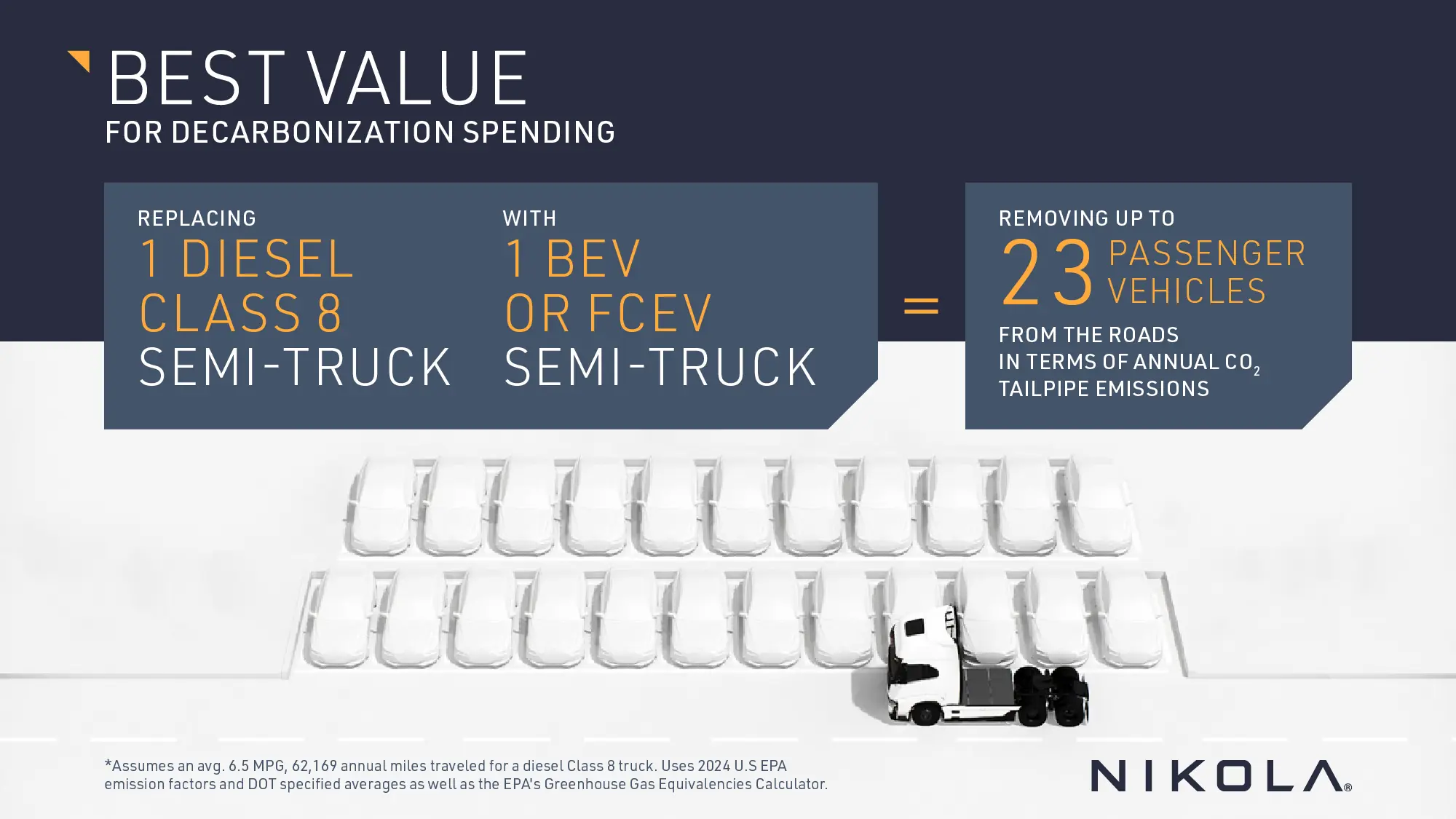
Zero-emissions benefit ports and communities
U.S. shipping ports and the communities that surround them are often the victims of poor air quality and noise pollution, one of the many goals of the Inflation Reduction Act, which aims to reduce diesel emissions around U.S. ports[15]. Battery-electric and hydrogen fuel cell electric trucks have zero tailpipe emissions and minimal idling noise, benefiting those working and waiting at shipping ports and the communities that surround them, especially the fragile ecosystem that surrounds port locations. Recently, the Port of Miami restored 40 acres of mangroves at Oleta River State Park, planted trees at the port, and relocated coral to a designed habitat area, hoping to increase the port’s climate resilience and support wildlife diversity.[16]
Battery-electric and hydrogen fuel cell electric vehicles can lead to new jobs by extending our alternative transportation infrastructure
Consumption of goods will likely increase as the world’s population increases – by 2025, the EPA has projected that commerce in the U.S. for goods will increase by 23.5% and by 45% by 2040.[17] The need for alternative fuel transportation options is likely to continue to grow with added policies and regulations, making space in the industry for alternative fuels and zero tailpipe emissions heavy-duty trucks. With alternative-fuel heavy-duty trucks gaining ground, infrastructure must expand to create paths for battery-electric to charge and hydrogen fuel cell electric vehicles to refuel. With a vibrant community built around truck refueling stations, new jobs likely will be created to expand and manage these alternative refueling stations for zero tailpipe emission trucks.
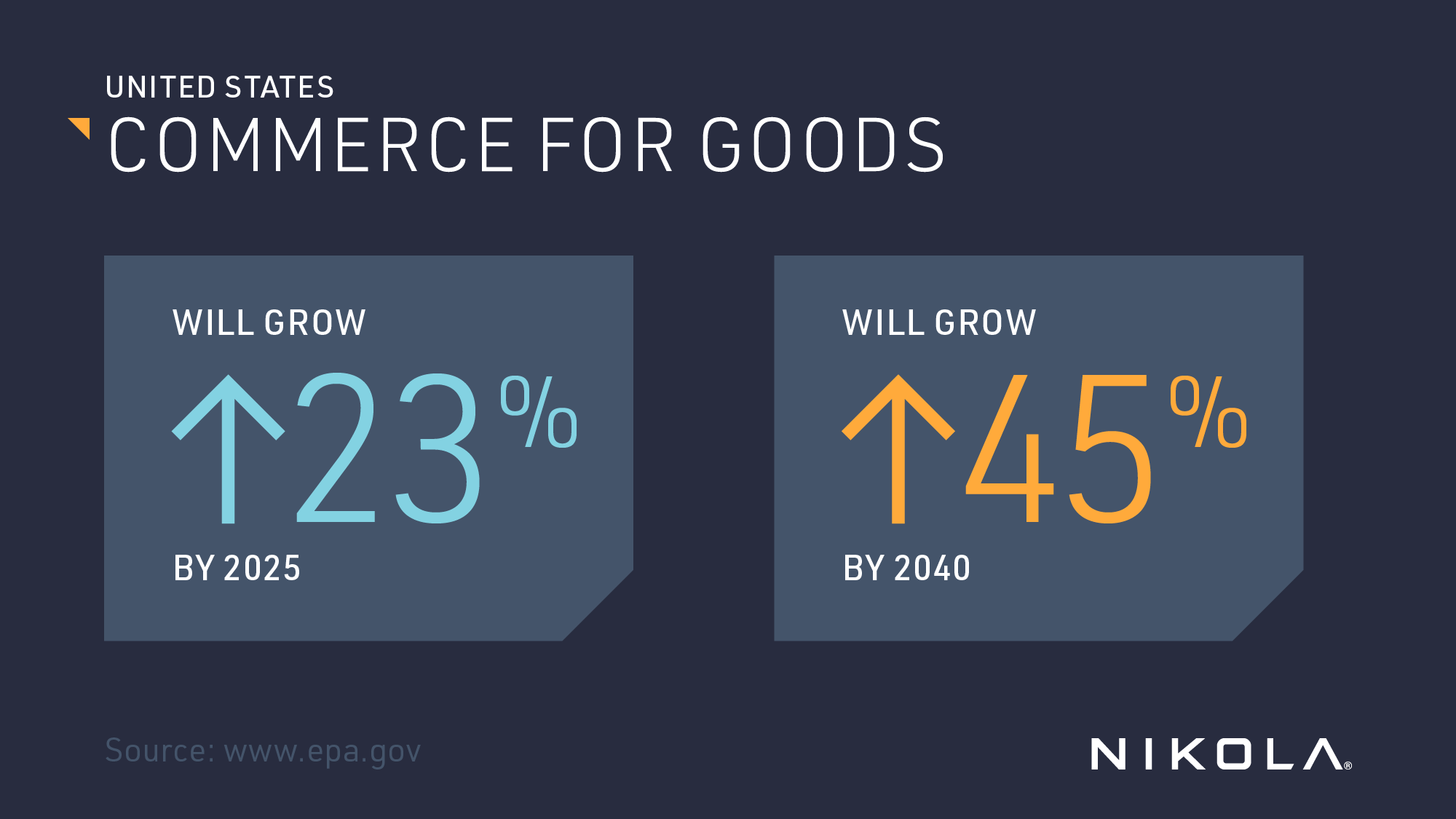
Benefits for drivers
The most important sustainability benefit of zero tailpipe emission heavy-duty trucks may be the benefits to drivers. The health benefits to drivers who drive alternative fuel trucks are numerous.
In Nikola trucks, for instance, the lack of diesel fumes allows drivers to open cab windows without breathing in harmful gases. The trucks can also offer a significant reduction of noise and vibration, increased visibility in the cab, and less stress on drivers’ elbows and shoulders as they move away from gear-shift-dependent diesel trucks. This increased cabin comfort may reduce physical and mental recovery time after shifts, potentially improving long-term health and wellbeing and improving quality of life for drivers.
“I LOVE THAT IT’S A LOT QUIETER THAN A DIESEL. WITH THE DIESEL I WAS LIKE ‘OK, I NEED TIME TO UNWIND’, VS THE NIKOLA I COULD JUST GET HOME AND SPEND TIME WITH MY KIDS.” -IMC LOGISTICS
The 100+ year habit of fossil fuel usage and associated emissions won’t change overnight, although legacy diesel heavy-duty truck manufacturers are working towards cleaner options. Nikola’s legacy is zero tailpipe emission trucks, and we are solely focused on that mission with purpose-built semi-trucks delivered and used on roads today.
Sustainability for the heavy-duty trucking industry is not just a nice-to-have, it can benefit our planet, people, communities, businesses, and drivers.
[1] Fast Facts on Transportation Greenhouse Gas Emissions. U.S. Environmental Protection Agency. [PDF file]. Available at: https://nepis.epa.gov/Exe/ZyPDF.cgi?Dockey=P101AKR0.pdf
[2] Fast Facts on Transportation Greenhouse Gas Emissions. U.S. Environmental Protection Agency. [PDF file]. Available at: https://nepis.epa.gov/Exe/ZyPDF.cgi?Dockey=P101AKR0.pdf
[3] Fast Facts on Transportation Greenhouse Gas Emissions. U.S. Environmental Protection Agency. [PDF file]. Available at: https://nepis.epa.gov/Exe/ZyPDF.cgi?Dockey=P101AKR0.pdf
[4] Reducing Carbon Emissions from Long-Haul Trucks. MIT Climate Portal. Available at: https://nepis.epa.gov/Exe/ZyPDF.cgi?Dockey=P101AKR0.pdf
[5] Winton, Alexander. “Encyclopedia of Cleveland History.” Case Western Reserve University.
[6] Cleveland Diesel Engine Division of General Motors Corp. “Encyclopedia of Cleveland History.” Case Western Reserve University.
[7] The History of Semi Trailer Trucks. Great Western Transportation. Available at: https://www.gwtrans.com
[8] Economics and Industry Data. American Trucking Associations. Available at: https://www.trucking.org
[9] Reducing Carbon Emissions from Long-Haul Trucks. MIT Climate Portal. Available at: https://climate.mit.edu
[10] Why Freight Matters to Supply Chain Sustainability. U.S. Environmental Protection Agency. Available at: https://www.epa.gov
[11] Linking ESG Initiatives to Financial Performance. McKinsey. Available at: https://www.mckinsey.com
[12] Why Sustainability Matters for Trucking Success. Fuel Smarts. Trucking Info. Available at: https://www.truckinginfo.com
[13] Linking ESG Initiatives to Financial Performance. McKinsey. Available at: https://www.mckinsey.com
[14] Do Consumers Care About Sustainability & ESG Claims? McKinsey. Available at: https://www.mckinsey.com
[15] EPA Launches Multi-Billion-Dollar Effort to Boost Air Quality Around U.S. Ports. Environmental Health News (EHN). Available at: https://www.ehn.org
[16] Issue Brief: Climate Change Mitigation and Adaptation at U.S. Ports (2022). White Papers. Environmental and Energy Study Institute (EESI). Available at: https://www.eesi.org
[17] Why Freight Matters to Supply Chain Sustainability. U.S. Environmental Protection Agency. Available at: https://www.epa.gov
